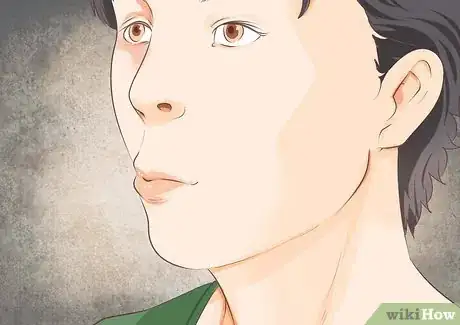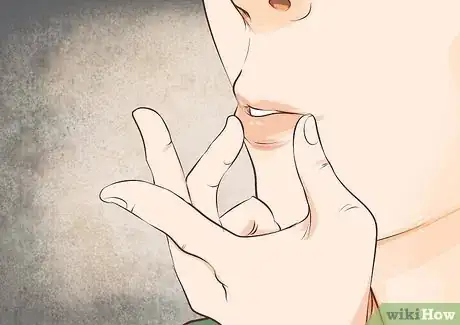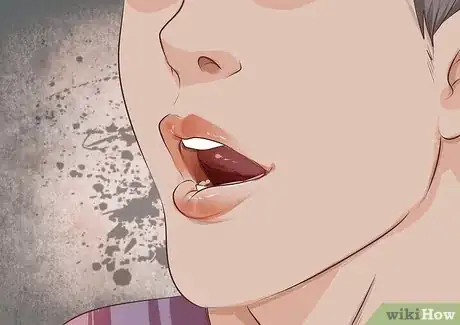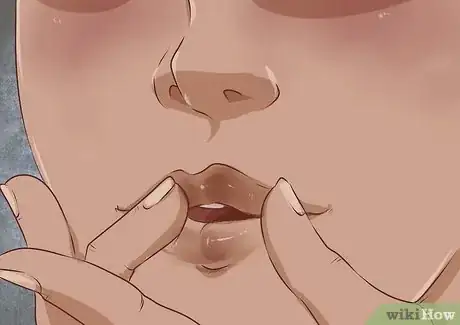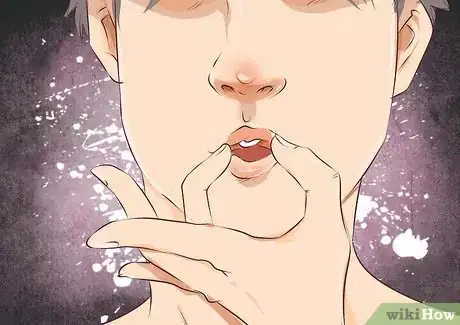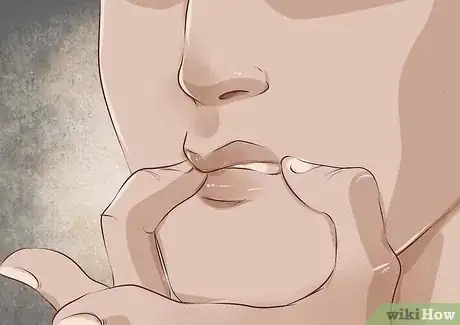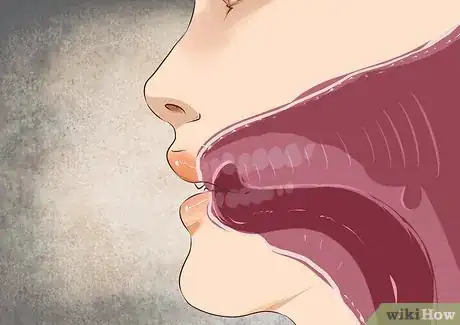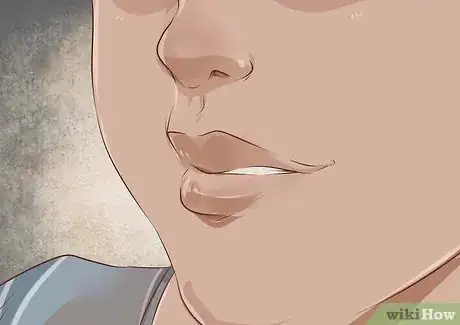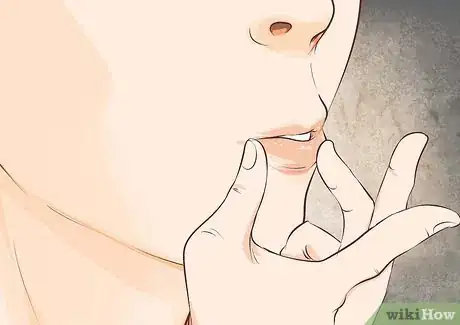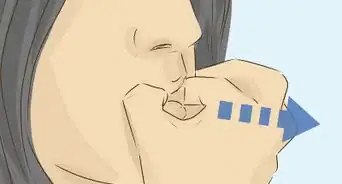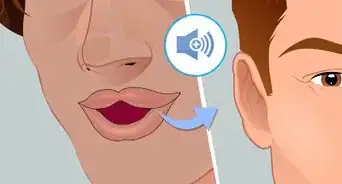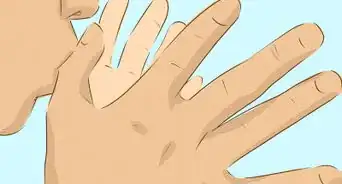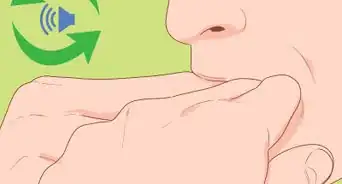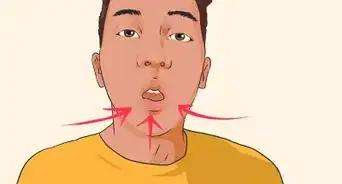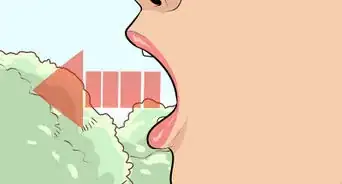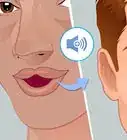wikiHow is a “wiki,” similar to Wikipedia, which means that many of our articles are co-written by multiple authors. To create this article, 40 people, some anonymous, worked to edit and improve it over time.
This article has been viewed 646,386 times.
Learn more...
Whistling is a task that takes skill and patience to master. There are many types of whistles, but one of the loudest is the wolf whistle. There are multiple ways to learn to wolf whistle, with and without using your hands. If you follow a few simple steps, you will be able to wolf whistle in no time.
Steps
Using Your Fingers to Wolf Whistle
-
1Position your lips. Wet your lips, open your mouth slightly, and pull your lips back over your teeth until your teeth are completely covered. Your lips should be tucked entirely into your mouth, so that only the outer edges of your lips visible.
- You may need to move your lips around when you begin to practice the whistle, but for now, keep them wet and tucked inside your mouth.[1]
-
2Position your fingers. The role of your fingers is to keep your lips in place over your teeth. Hold your hands up with your palms facing you. Hold your index and middle fingers close together in front of you, with your thumbs holding down your ring and pinky fingers. Press the sides of your middle fingers together to make an "A" shape.[2]
- You can also use your pinkies. Hold your hands the same way, holding up your pinkies instead of your index and middle fingers.[3]
- You can also use one hand. Hold one hand up, and make the okay sign by pressing the tip of your index finger and thumb together. Then separate your fingers slightly, leaving a small space between your fingers for the air to escape. Keep your other fingers out straight.[4]
Advertisement -
3Position your tongue. The whistle sound is produced by air flowing over a bevel, or a sharply angled edge. In this case, the sound is created by the upper teeth and tongue directing air onto the lower lip and teeth. To make this sound, you need to position your tongue correctly in your mouth.
-
4Make final adjustments. Your lips should still be wet and cover your teeth. Keep your fingers about a knuckle into your mouth, still holding your tongue in place, which should be folded back on itself. Close your mouth enough to make a tight seal around the top, bottom, and outer edges of your fingers.[7]
-
5Blow out of your mouth. Now that your lips, fingers, and tongue are in position, you need to start blowing out air so you can finally whistle. Inhale deeply and then exhale, pushing the air out of your mouth over the top of your tongue and lower lip. If air is coming out of the sides of your mouth you need to make a tighter seal with your lips on your fingers.
- Don’t blow too hard at first.
- As you blow, adjust your fingers, tongue and jaws to find the bevel’s sweet spot. This is the area of maximum efficiency for your whistle, where the air is blown directly over the sharpest part of the bevel.
-
6Listen for the sounds as you practice. Your mouth will start to focus the air onto the bevel’s sweet spot with increasing accuracy as you practice. Once you locate the sweet spot, your whistle will have a strong, clear tone, as opposed to a breathy, low-volume sound.
- Make sure you don't breath too fast or too often while you are practicing. You don't want to hyperventilate. If you take your time, you will have more breath to practice with.
- Using your fingers to apply some extra downward and outward pressure onto the lips and teeth may also be helpful. Experiment with the position of the fingers, tongue, and jaw.[8] [9] [10]
Mastering the Fingerless Whistle
-
1Draw back your bottom lip. The fingerless wolf whistle is achieved through lip and tongue placement. Push your lower jaw forward slightly. Pull your bottom lip up over your teeth. Your bottom teeth should not be visible, but your upper teeth can be.
- Your bottom lip should be snug against your lower teeth; if you need help with this movement, press your index and middle fingertip on either side of the mouth to draw your lip slightly out at the corners and over your lips.[11]
-
2Position your tongue. Draw back your tongue so that it is even with your lower front teeth and flat against the bottom of your mouth. This action also broadens and flattens the front edge of the tongue, yet there is still a space between the tongue and the lower front teeth. The sound of the whistle comes from air that is blown over the bevel, or a sharply angled edge, you create with your tongue and lips.[12]
- As an alternative, flatten out your tongue so that the sides of your tongue are pressed against the edges of your back teeth. Roll the tip of your tongue down slightly, making a "U" shaped dip in the middle where air can pass out from behind your tongue.[13]
-
3Blow air out of your mouth. Using your upper lip and teeth, direct the air downwards and towards your lower teeth. The focus of the air is crucial for this technique. You should be able to feel the air on the underside of your tongue. And if your hold your finger below your lower lip, you should feel the downward thrust of air when you exhale.[14] [15]
-
4Adjust your tongue and jaw to find the sweet spot. Your whistle may start out sounding breathy in a lower-volume that fades in and out, but don't worry. You just need to find the area of maximum efficiency, where the air is blown directly over the sharpest part of the bevel you've made in your mouth. Keep practicing to increase the volume of your whistle.[16]
- Make sure you don't breath too much or too fast while you practice. You don't want to hyperventilate. If you take your time, you will have more breath to practice with.[17]
Community Q&A
-
QuestionAm I supposed to put my fingers inside of my mouth?
 Community AnswerYou can put your fingers inside of your mouth, but you don't have to. If it helps you do this, it would okay.
Community AnswerYou can put your fingers inside of your mouth, but you don't have to. If it helps you do this, it would okay.
References
- ↑ http://www.artofmanliness.com/2012/04/08/how-to-whistle-with-your-fingers/
- ↑ http://www.artofmanliness.com/2012/04/08/how-to-whistle-with-your-fingers/
- ↑ https://www.youtube.com/watch?v=CCJ3pl1LLQ8
- ↑ https://www.youtube.com/watch?v=_4Z7rODCPpQ
- ↑ http://www.artofmanliness.com/2012/04/08/how-to-whistle-with-your-fingers/
- ↑ https://www.youtube.com/watch?v=CCJ3pl1LLQ8
- ↑ http://www.artofmanliness.com/2012/04/08/how-to-whistle-with-your-fingers/
- ↑ http://www.artofmanliness.com/2012/04/08/how-to-whistle-with-your-fingers/
- ↑ https://www.youtube.com/watch?v=mYpmyE1fliE
- ↑ https://www.youtube.com/watch?v=_4Z7rODCPpQ
- ↑ https://www.youtube.com/watch?v=_4Z7rODCPpQ
- ↑ https://www.youtube.com/watch?v=_4Z7rODCPpQ
- ↑ https://www.youtube.com/watch?v=pivSGnHWbn4
- ↑ https://www.youtube.com/watch?v=_4Z7rODCPpQ
- ↑ https://www.youtube.com/watch?v=pivSGnHWbn4
- ↑ https://www.youtube.com/watch?v=_4Z7rODCPpQ
- ↑ http://www.artofmanliness.com/2012/04/08/how-to-whistle-with-your-fingers/
About This Article
To wolf whistle, start by wetting your lips and pulling them back so they're covering your teeth. Then, hold your hands with your palms facing toward you and press your index and middle fingers together to make an "A" shape. Next, use your fingers to press your tongue back so it curls toward the back of your mouth. When you're ready, blow out of your mouth to start whistling. If you don't whistle at first, keep adjusting your fingers and mouth until you get it! To learn how to wolf whistle without your fingers, scroll down!
